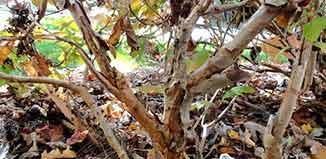Flower garden
 Apply mulch around trees and shrubs to retain moisture for spring and summer months.
Apply mulch around trees and shrubs to retain moisture for spring and summer months.
Prune deciduous shrubs which flower in summer, most roses and hydrangeas.
Make sure your climbers are well secured to their supports. Cut vigorous climbers such as ivy, climbing hydrangeas and Virginia creeper well back from your windows and gutters if they’re planted on house walls.
Cut leaves away from hellebores and epimediums so that the flowers are shown off as they emerge — it also reduces the risk of fungal disease – or plant new hellebores, available now in flower at garden centres.
Dead-head proteas as soon as flowers fade, pruning the bush as you go.
Spring-flowering bulbs are beginning to show their noses — sprinkle a few slug pellets about as you see signs of life, although those in pots should be reasonably safe.
Take hardwood cuttings of cornus, forsythia, ribes, roses, salix, viburnum, weigela, and other suitable shrubs.
Towards the end of the month plant gladioli, dahlias and calla lilies for summer flowering. Gladioli will flower approximately 100 days after planting.
Sow seeds of aquilegia, delphinium, dianthus, larkspur, nemesia, pansy, primula, salvia, snapdragon, stock, sweet-pea and wallflower.
Plant out seedlings of pansies, primula, sweet-pea, lupin, stock, lobelia, larkspur and dianthus.
Fruit and vegetable garden
 Plant new rhubarb crowns, strawberry plants, asparagus crowns, garlic and shallots.
Plant new rhubarb crowns, strawberry plants, asparagus crowns, garlic and shallots.
Build up your vegetable beds with compost, but don’t cultivate wet, boggy soils. Raised beds may be the only solution for heavy soils with severe drainage issues.
Sow seeds of broccoli, cabbage, broad beans, cauliflower, peas, lettuce, onions, radish, spinach, silver-beet, swede and turnips.
Plant out seedlings of artichoke, cauliflower, lettuce, onions, potatoes, silver-beet and cabbage – the use of a cloche protects plants from wet and cold, and allows for earlier plantings.
Control slug and snail populations with bait such as Quash, or beer traps.
Snail colonies sheltering under rocks and piles of decaying leaves should be cleared away and disposed of.
Pick winter lettuce, leaf by leaf, to prevent waste — rocket, lamb’s lettuce and chicory cope with cold.
Rust can be a problem on broad bean plants, celery, beetroot, garlic, leeks, chives and shallots, especially in poorly drained soil, or where there’s poor air flow. Remove infected leaves immediately and dispose carefully. A copper or general fungicide spray may be needed.
Plant new fruit trees — citrus, apples, pears, plums, peaches and nectarines.
Prune deciduous fruit trees, and protect with pruning paste.
Spray fruit trees with copper spray if they are infected by curly leaf.
Lawns
Mid-winter lawns differ in the type of treatment they need, depending on the sort of lawn used. Summer-growing lawns such as kikuyu and couch grass slow down in autumn, and almost stop growing altogether in winter. They need little care, and virtually no mowing.
In gardens where Kentucky bluegrass has been planted, they will continue to grow, needing only gentle feeding, and the occasional mow.
Second thoughts
Water- blast paths now — it will remove nutrients which feed algae. Re-cut your lawn edges, and fill in bare patches and hollows with new turf for a fresh, clean finish.

